This Rhode Island county has some of the worst ozone pollution in the Northeast
PROVIDENCE – When you think of Washington County, you may conjure images of ocean beaches and lush forests.
What probably doesn’t come to mind is smog.
Yet Rhode Island’s southernmost county chronically grades poorly for pollution from ozone – a gas that’s the main component of smog – in the American Lung Association’s annual assessment of air quality.
The pattern continues in the 2024 State of the Air report, the 25th edition of an analysis based on data from air-quality monitors collected by the U.S. Environmental Protection Agency.
In the new report that was released Wednesday morning, Washington County was ranked the worst county for ozone in the Boston-Worcester-Providence metro area and the third-worst in the Northeast.

Why does Washington County have a smog problem?
Ozone is beneficial in the atmosphere as a shield from ultraviolet radiation but is a pollutant at ground level, causing breathing problems and lung damage. It forms when emissions from tailpipes, power plants and factories react under sunlight.
Washington County is vulnerable to ozone pollution because of its location.
Clouds of the gas, fueled by discharges from traffic and heavy industry, drift north along the I-95 corridor from New York and New Jersey and from as far east as the Ohio Valley.
While the out-of-state pollution contributes to poor air-quality days in the Providence metro area and other urban parts of Rhode Island, Washington County typically gets hit harder.
Providence and Kent counties received C grades for ozone in the 2024 report
Washington County received a D grade, with 3 days of unhealthy levels annually for the three-year period from 2020 to 2022. That’s up from 2.2 days in last year’s report.
“It shows that not just urban areas are affected by pollution,” said Dan Fitzgerald, director of advocacy for the American Lung Association in Rhode Island.
There are no air-quality monitoring stations in Newport or Bristol counties to transmit data.
More: Wandering wildfire smoke from afar shows Rhode Island can't escape climate reality
Electric cars expected to help with air pollution
The data also demonstrate that there’s only so much individual states can do to address air pollution, which is affected by local and regional factors.
“We all share the air that we breathe,” Fitzgerald said.
He says there’s reason to believe things will get better. States are adopting regulations in support of electric vehicles that are modeled on a policy first rolled out in California.
Rhode Island is in the process of enacting the rules, which require automakers to increase sales of zero-emission vehicles. And upwind states, including New York and New Jersey, have already done so.
While phasing out the sales of new gas-powered cars is aimed at reining in planet-warming greenhouse gas emissions, the policy would also reduce levels of ozone and particulate matter, another type of pollutant that consists of tiny solids from vehicle exhausts, smokestacks or fires that can be inhaled and cause health problems.
Rhode Island is within federal standards for air pollution
Despite the lagging grades for ozone, three Rhode Island counties were within the EPA‘s standards for air pollution, but that hasn't always been the case.
Two years ago, Providence County was above acceptable levels for ozone
Three years ago, Washington County was above the acceptable level, and two years ago it was at the standard for air pollution
Both counties, as well as Kent County, have seen huge improvements since the mid-1990s when the EPA put in place more stringent vehicle emissions rules for the nation. Twenty years ago, the three counties were experiencing 25 or more high ozone days annually.
And even though Washington County doesn’t compare favorably to other places in the Northeast for ozone levels, it’s still far better than counties with the worst smog pollution in the country. Some counties in California averaged more than 100 high-ozone days annually for the three-year study period.
Nationwide, 39% of Americans live in in places with failing grades for ozone or particulates. The 2024 report found more people breathing unhealthy air than in the previous year, due to a combination of extreme heat, drought and wildfires, which are all exacerbated by climate change.
Effects of Canadian wildfires aren't included in this year's air report
Rhode Island has generally performed well for particle pollution in the State of the Air assessments. The 2024 report is no different, with Washington County getting an A grade and Kent and Providence getting Bs.
But the report doesn’t include data from last year, when for long stretches of the spring Northeast skies were marred by smoke from enormous wildfires burning in Canada. Those numbers will figure into next year’s report.
“That will be interesting,” Fitzgerald said.
This article originally appeared on The Providence Journal: Smog from New York, New Jersey pollutes Washington County air, report finds
